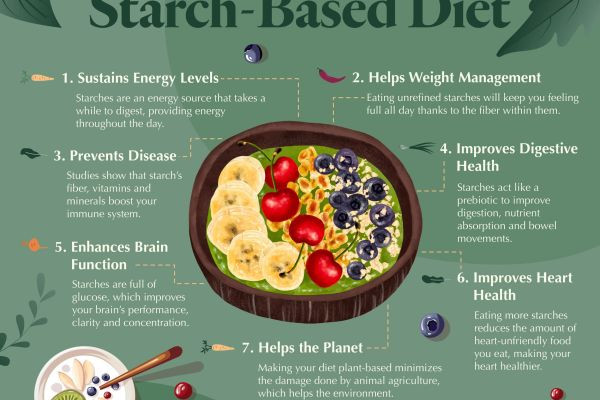Starch is one of the most common and essential nutrients in the human diet. As a complex carbohydrate, it is found in a variety of plant-based foods and serves as a major energy source for billions of people worldwide. Despite its importance, starch often carries a dual reputation—on the one hand, it's a vital part of a healthy diet, providing the necessary fuel for our bodies; on the other, it’s frequently associated with unhealthy foods that contribute to weight gain and lifestyle diseases. Understanding starch, its nutritional benefits, potential risks, and its role in the human diet is critical for promoting balanced eating and overall well-being.
What is Starch?

Starch is a type of carbohydrate composed of long chains of glucose molecules. It is categorized as a complex carbohydrate due to its structure, which requires more time for the body to break down compared to simple sugars like sucrose or fructose. This slow digestion provides a steady release of glucose into the bloodstream, making it an efficient and sustainable source of energy.
Starch is naturally found in many staple foods such as grains (like rice, wheat, and corn), tubers (such as potatoes and cassava), legumes (beans and lentils), and certain fruits (bananas, for example). It is also a common ingredient in processed foods, ranging from bread and pasta to snacks and cereals. Due to its wide availability and affordability, starch is a key component of diets across cultures and socio-economic backgrounds.
The Nutritional Benefits of Starch
1. Energy Production
The primary function of starch in the diet is to provide energy. Carbohydrates, including starch, are broken down into glucose, which is the body’s main fuel, especially for the brain and muscles. For individuals with active lifestyles, starch-rich foods are invaluable because they offer long-lasting energy compared to simple sugars, which cause rapid spikes and crashes in blood sugar levels.
2. Supports Digestive Health
Some types of starch, known as resistant starch, can promote better digestive health. Resistant starch is not fully broken down and absorbed by the small intestine, instead reaching the colon, where it acts as a prebiotic. It feeds beneficial gut bacteria, which in turn can improve gut health, reduce inflammation, and lower the risk of diseases such as colon cancer. Foods rich in resistant starch include lentils, green bananas, and cooked-then-cooled rice or potatoes.

3. Satiety and Weight Management
Complex carbohydrates like starch can contribute to feelings of fullness or satiety, which can aid in weight management. Because starch takes longer to digest, it helps control appetite and reduces the likelihood of overeating. By maintaining stable blood sugar levels, it helps to avoid cravings that are typically associated with refined sugars.
4. Nutrient-Dense Source
Whole food sources of starch—such as whole grains, legumes, and vegetables—are often nutrient-dense. They provide not only carbohydrates but also essential vitamins, minerals, and fiber. Whole grains like brown rice, oats, and whole wheat are excellent examples of foods that offer the benefits of starch while delivering nutrients like B vitamins, iron, and magnesium.
The Risks of Overconsumption and Refined Starches
While starch has many health benefits, it’s important to differentiate between whole-food sources of starch and processed or refined starches, which can have detrimental effects on health when consumed in excess.
1. Refined Starches and Processed Foods
Refined starches are found in many processed foods, including white bread, pastries, sugary cereals, and many snack foods. During the refining process, the fiber and nutrients are stripped away, leaving behind only the carbohydrate content. These refined starches are quickly digested and absorbed, leading to rapid increases in blood sugar and insulin levels. Over time, regular consumption of refined starches can contribute to insulin resistance, type 2 diabetes, and obesity.
2. Increased Risk of Obesity and Chronic Diseases
Consuming large amounts of refined starches can lead to weight gain and increase the risk of chronic diseases like heart disease, diabetes, and certain cancers. Since these foods are often calorie-dense and lacking in fiber, they don’t promote feelings of fullness, causing individuals to overeat and consume more calories than they burn. Furthermore, the frequent spikes and crashes in blood sugar levels from refined starches can increase cravings for more sugary or starchy foods, creating a vicious cycle of poor dietary habits.
3. Digestive Issues
For some individuals, consuming too much starch can lead to digestive issues like bloating, gas, and constipation, particularly if the starches come from refined sources low in fiber. On the other hand, resistant starches can sometimes cause discomfort in those with sensitive digestion or conditions like irritable bowel syndrome (IBS), where certain types of carbohydrates can trigger symptoms.
Balancing Starch in the Diet
To make starch a beneficial part of the diet, it’s essential to focus on quality, variety, and moderation. Here are some tips for incorporating healthy starches into your meals:
1. Choose Whole Foods
Opt for whole-food sources of starch rather than refined and processed varieties. Whole grains like quinoa, barley, and brown rice are excellent choices, as they contain the entire grain kernel, including the bran, germ, and endosperm, making them richer in fiber and nutrients.
2. Include Legumes and Vegetables
Legumes like lentils, chickpeas, and black beans are great sources of both protein and starch. They are nutrient-dense and low in fat, making them ideal for balancing energy needs with health benefits. Root vegetables such as sweet potatoes, yams, and carrots also offer complex carbohydrates along with essential vitamins and minerals.
3. Watch Portion Sizes
While starch is an important part of a balanced diet, it’s easy to overconsume starchy foods, particularly in cultures where rice, pasta, or bread dominate the plate. Aim to fill your plate with a variety of food groups, including vegetables, proteins, and healthy fats, alongside starches. Portion control can help manage caloric intake while still reaping the benefits of carbohydrates.
4. Balance with Fiber and Protein
To prevent rapid spikes in blood sugar, pair starchy foods with sources of fiber, protein, and healthy fats. For example, combining whole grains with lean proteins and vegetables can create a balanced meal that promotes stable energy levels and prolonged satiety.
Conclusion: Starch as a Key Component of a Healthy Diet
Starch is a valuable nutrient that plays an essential role in providing energy, supporting digestive health, and promoting satiety. However, not all starches are created equal. The key to harnessing the benefits of starch lies in choosing whole-food sources over refined, processed options, and balancing starch intake with other macronutrients like fiber, protein, and healthy fats.
Understanding the nutritional nuances of starch can empower individuals to make informed dietary choices that support long-term health and well-being. By focusing on quality, variety, and moderation, starch can be an integral part of a balanced and nutritious diet.



